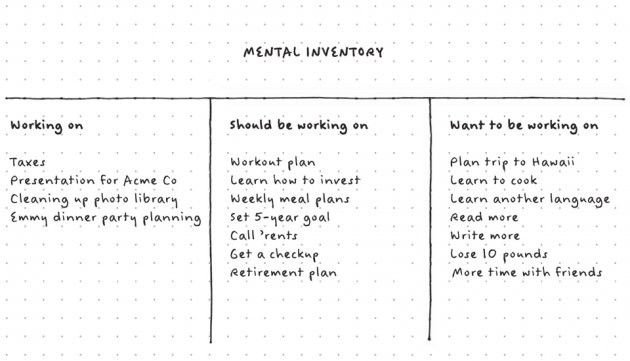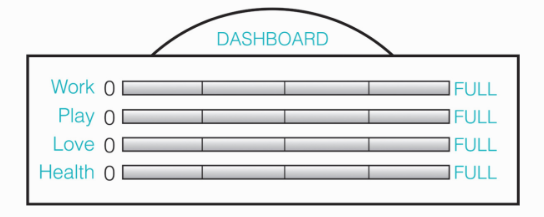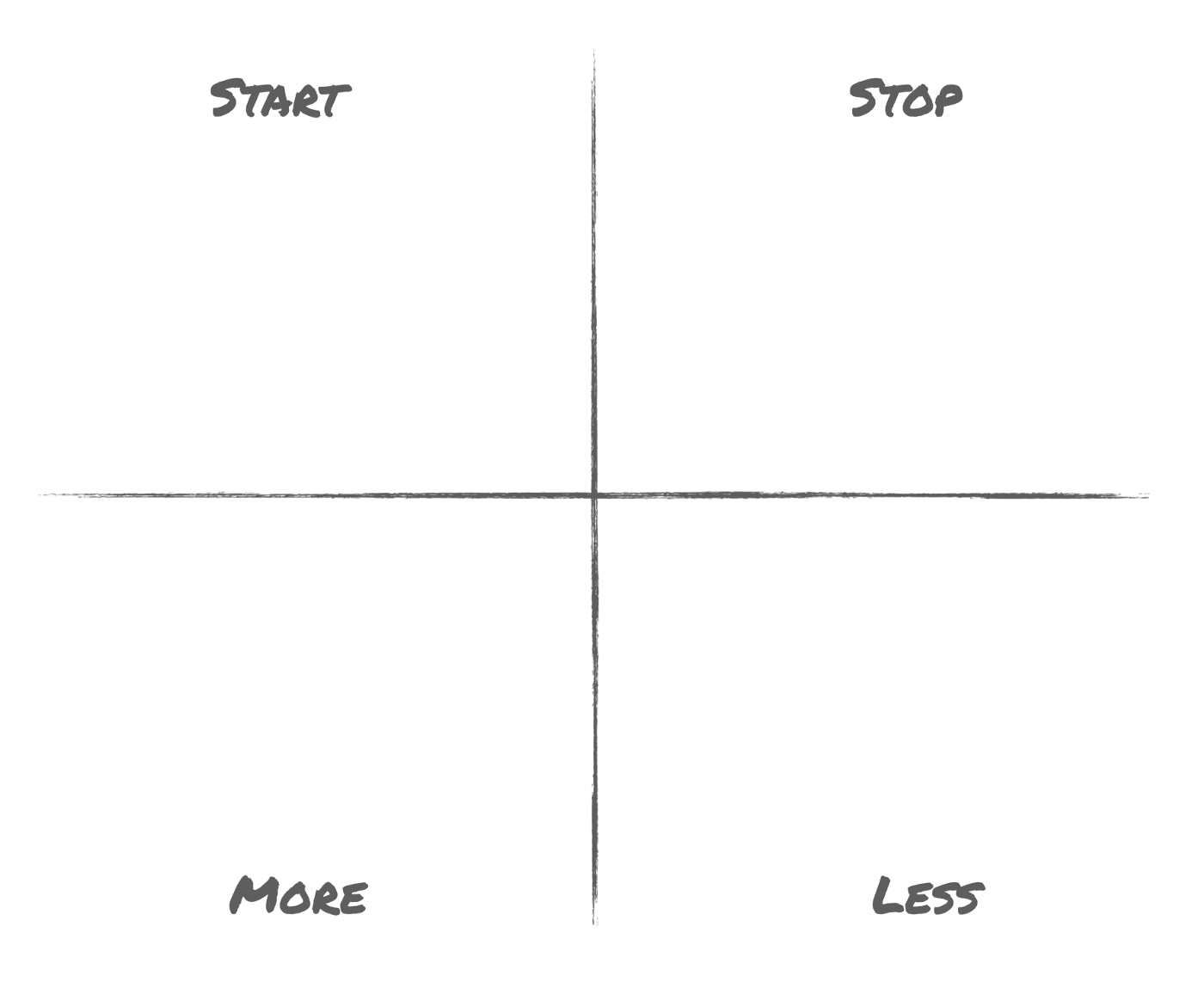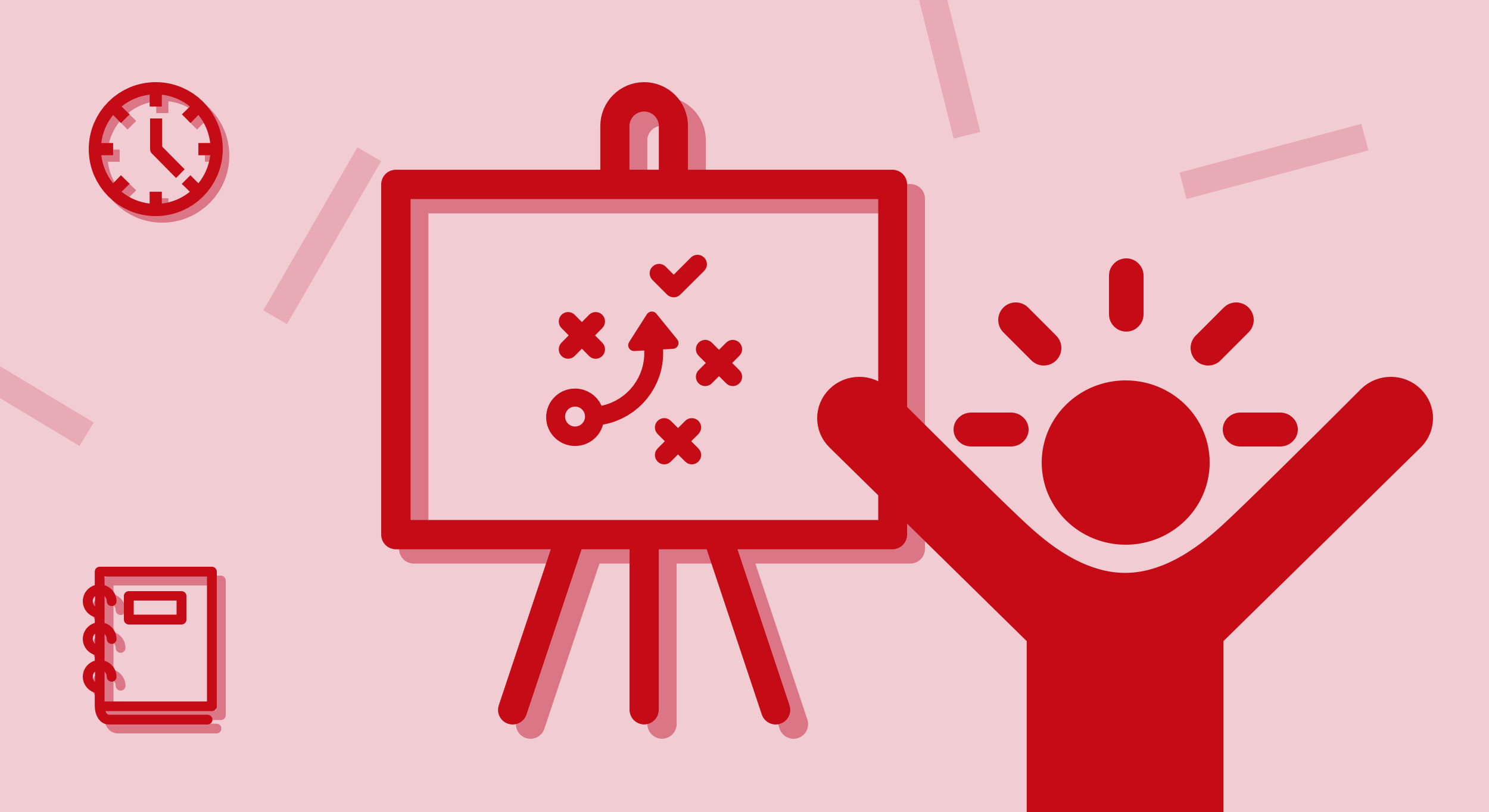A note since I first published this article:
It’s safe to say that this year [2020] has turned out like none of us could have anticipated. So it’s likely that the goals you may have set at the start of the year aren’t so relevant anymore. I know the feeling. But this isn’t something to feel disheartened by. Whether you’re a business or an individual, revisiting your goals and adjusting them on a regular basis is super important. It’s never too late, or too early, to start over. I wrote the approach below at the start of the year, as part of my personal, annual goal-setting cycle, but you can apply it at any time. Taking a moment halfway through the year is a great time to use the following approach to consider what you’d like to achieve for the rest of the year. It’s even more worthwhile in light on unexpected circumstances (I was about to write ‘unprecedented’ there and I had to check myself). If you’re feeling cloudy about what’s to come in the future, or you need clarity around your priorities, have a read of the below. I hope it’ll help you clear the fog!
I don’t know about you but the first full week of every new year usually ends with a fist bump and shouts of “We made it!”, followed by lots of chat about new goals for the new year. Full disclosure — the reason for this on my side is 100% because I can never stop talking about it. In fact, I’m guilty of telling anyone who’ll listen about my approach to setting goals and intentions, and how I feel transformed since putting in the time to focus on this. If you’re a friend or colleague of mine then you’re probably sick to the back teeth of hearing me hammering on about this and, therefore, I’m sure you’ll be delighted to see that I’ve now written a blog about it, too. You’re welcome.
My obsession with goal setting started over the Christmas period of 2018, when my wise friend and previous colleague — Fola Abari — started talking to me about living our lives more intentionally. We were the only people in our team who were working over the Christmas period and, therefore, spent a lot of time getting each other excited about the new people we could be in 2019, by being more intentional in everything that we do. She was reading ‘The Bullet Journal’ at the time which had some pretty nifty tips for setting meaningful goals, so we quickly started putting these into practice. More on that later.
Since then, corny as it sounds, I feel like I’ve been on a real journey — some things worked, and a lot of things didn’t. Sometimes I was hyper focused, and other times I wandered aimlessly. Some goals were met, and others not even close. But throughout it all, I had something to return back to, my initial goals, which helped me to anchor myself, and better reflect on the good and the bad. And you know what? By the end of that year, I was able to look back and create a list of achievements that I’m actually proud of. Some of the things I did directly related to the goals I set at the start of the year, some took me on an entirely different path. But above all, I ended the year with a better understanding of who I am, what’s important to me and what I’m striving for. I felt like I could give myself a deserved pat on the back which, for someone who's suffered from a demon of an inner critic for all of my life (I’m a Virgo, can you tell?), this was pretty huge.
When it came to goal setting for 2020, I felt better prepared and clearer than ever to create some goals that were not only more meaningful to me, but which I could actually achieve, too. Something had clicked. And, for that reason, I wanted to write down what I’ve learnt so far, so that I can read this back at the end of another year but, also, in the hope that someone else might find something useful in this for themselves, too.
My guide to goal-setting greatness!
First things first, you can’t do anything until you’ve got yourself a badass notebook that will give you the attitude and energy that you need to be motivated to get shit done. Here are the one’s that I’m using below. The pink one on the left is the one I used last year and is now what I use to capture any notes or reflections, and then the fancy, personalised one on the right is my new one for 2020. This one is notebook/planner mashup which will allow me to capture what I’m doing on a week-by-week basis towards my goals. Anyone who knows me will know that I’m a sucker for stationery so these two cuties bring me so much joy — shoutout to all my fellow stationery nerds, I see you!

Essentially, you just need somewhere that you can record your thoughts, goals and reflections. Good old neuroscience tells us that we need to write down our goals if we actually want to achieve them, as explained in this Forbes article. It’s not lost on me that many of you might be thinking that you could easily just chuck all of this in your iPhone notes, but the power of committing pen to paper shouldn’t be sniffed at. The act of physically committing your thoughts to paper feels much more powerful than in digital form, where the ability to edit is too easy. By writing things down with pen and paper, the filtering process that your brain goes through is heightened since you don’t have the ease of editing in the way you do on your phone. So, there.
Once you have your suitably badass notebook in hand, which I really must insist upon, you’re ready to go. So, without further ado, here are my five top tips for creating some equally badass goals that are meaningful to you, and which you’re actually likely to achieve:
1. Start by looking back
No one wants to linger in the past but taking a minute to reflect on the previous year can reveal some good hints for the future. This doesn’t mean beating yourself up about goals you didn’t achieve, though. I used to be terrible for that. The result would be rolling old goals into the new year, along with a disingenuous belief that, for some reason, things would be different this time. I was setting myself up to fail.
Now, I take a different approach — before doing anything else, I force myself to list out all of the successes from the last year, no matter how big or small, which, in turn, put me in the right, positive mindset to revisit my previous goals. For those that I didn’t achieve, rather than feeling rubbish about it, I considered why and, nine times out of 10, it turned out that the goal wasn’t that important in the first place. In the other cases, I thought about what worked and what didn’t work so that for any goals that I was intending to roll over, I had an idea of what I needed to do more or less of to be able to succeed.
2. Have a mental detox — get everything out of your head
This is where one of the methods from ‘The Bullet Journal’ comes in real handy. The author recommends getting a piece of A4 paper and splitting it into three parts. In the first column, list all the things that you’re currently doing. In the second, list all the things that you feel you should be doing. Finally, in the last column, list all of the things that you wish you were doing. You then go wild, writing down all of the things that are buzzing around in your head, taking up space. Go for quantity here — write down everything from the mundane (such as sorting your gdrive and doing your taxes) to the exciting (like planning your dream trip or learning a new skill).

3. Spot the goals from the distractions
If you were to follow the ‘Bullet Journal’ approach religiously then the next thing you would do is go through your lists and ask yourself two questions: “Is this this vital?” and “Does it really matter?” This should help you get rid of the distractions, because if your answer is no for any of the goals in your lists then you should really cross it out. What you’re then left with is a list of goals and responsibilities that should feel a bit more doable than the lists you had when you started. However, I must admit that I prefer to use a slightly different approach. When compiling my own lists, I noticed that a lot of the things that I was writing down were either habits or actions, rather than goals, and I think that this is a really important distinction to make.
If your goals are to-do lists then they’re not really goals at all. In the same way, if your goals are just a set of new habits that you want to introduce into your life, then they’re not goals either. This is because actions and habits are really a means to an end — they’re the things that should help you to achieve a goal, but not the goal itself. In other words, they’re how you get there. The problem with habits and actions is that they only allow you to have one way to succeed. You either win or you lose. However, if your goals indicate what you want to achieve — a desired outcome — then you have the flexibility to explore multiple ways to help you achieve it. You can try things out and see what works.
The reason I thought it was important to separate the goals from the habits wasn’t because I think we need to disregard habits completely. Habits are incredibly important and I could write a whole new blog about them if I wanted to. However, to save this blog becoming a dissertation, I’ll suggest another book called ‘Atomic Habits’, by James Clear, which talks more about this and provides a blueprint for how to create new habits and making them stick. But, back to goal setting, my reason for separating the goals from the habits was actually to enable myself to align them, so that habits had an end goal, and goals had habits that might help me to achieve them.
4. Question everything — ask yourself why
For this tip, I have another book suggestion. This time it’s Simon Sinek’s, ‘Start with Why’. It’s about how the most successful, innovative and inspiring businesses all have one thing in common — they focus on why they do what they do, before anything else. In other words, they have a strong purpose (their why) and this governs everything else that they do (the what and the how).
This concept lends itself perfectly to personal goal setting and, I have to admit, this was a real revelation for me. When reflecting on the goals I‘d set in the past, I realised that some of them were actually what I thought I should be doing, but in reality they didn’t align with my personal purpose — which means they weren’t the things that get me up in the morning or things that I’m passionate about. By asking myself why, for each and every goal in my shortlist, I basically stress-test them. It enables me to be honest with myself about the goals I’ve written down. And you have to be brutal when you’re doing this, just like Marie Kondo — if it doesn’t spark joy then get it in the bin!
So here’s what you need to ask yourself — What gets you up in the morning? What are you passionate about? When are you at your happiest? Once you know the answers to these questions, you can then interrogate your goals. For each goal, you should ask yourself the following: Why is this important? Why do you care? Does it align to your purpose?
Oh and by the way, this works with actions and habits, too. If you ask why, you can identify what it is that you’re actually trying to achieve and, before you know it, you’ve uncovered the hidden goal.
5. Get your work/life balance in check
By this point, you’re probably thinking, “Surely there’s not more?!” Well, unfortunately for you, my friend, you would be wrong because as I said before, I’m a Virgo, and we are nothing if not dogged perfectionists. However, you’ll hopefully be pleased to know that this is pretty much the final step in my goal setting process. This is just one more stress-test, intended to highlight whether your goals are balanced or not.
This step is inspired by another book which I read many years ago when I was going through what I like to call my “Grad-Life Crisis” — the stage where you graduate, start your first job and realise you have no clue what you’re meant to be doing in life. To help me overcome my amateur dramatics, I read a brilliant book called ‘Designing your life’, by Bill Burnett and Dave Evans, of Stanford Design School. It’s a book about using Design principles to help you live a more fulfilling and enjoyable life. Early on in the book, the authors ask you to complete what they call a “Life Dashboard” where you rate the quality of your life against four different variables: Work, Play, Love and Health. It’s intended to highlight where you’re spending most of your energy and where is being starved of your attention.

This concept stuck with me and, when it came to goal setting, I decided to use it to determine how my goals were spread across these areas. It turned out that the vast majority of my goals sat under Work, followed closely by Health, whereas Play and Love had little to no related goals. It was a wake-up call. I went back to the drawing board and searched for goals that could sit under these two important, yet neglected, areas. If I said that I had cracked it at this point, I’d be lying. When I started incorporating the Life Dashboard into my goal-setting process, I did come up with more goals, however I think it’s safe to say that they were shoe-horned in and didn’t necessarily get me excited. As expected, when it came to reflecting on them after a year had passed, these were the goals that I didn’t achieve, but that was ok. It was clear to me that they weren’t as important as I initially thought. You don’t have to always achieve your goals to succeed, sometimes the learning process is enough. As a result of this learning, the goals I set under these headings the following year felt much more exciting and meaningful to me.
So what next?
You’ll be pleased to know that that’s where my goal setting process ends. But if you think that’s where the work stops then you’d be mistaken. It can be super tempting to write your goals in your notebook and just leave them there for the rest of the year, but the magic really happens in the regular reflection. Full transparency — I started 2019 by being militant about this, which naturally tailed off from weekly to monthly to sometimes even less than that across the year. But again, that’s ok because as long as I had something to return back to, it didn’t matter how often I reflected. As long as I did it at a time that worked me then that was enough.
I also like to have a more formal check-in midway through the year, usually in June, where I look at my goals and then make a list of what I’ve already achieved. Some of the achievements are directly related to a goal I set at the start of the year, others aren’t. It’s important not to limit yourself when making this list. Just write out all of the things you’re proud of from the last six months. Then it’s time to think about the following six months and, for this, I like to use a framework that I often use in strategy work with clients. It’s a framework for making choices and tradeoffs called “Start, Stop, More, Less”, and it’s a simple 4×4 as you can see below. You simply make a list in each of the sections, thinking about the things you want to start and continue doing, plus the things you need to stop or do less of.

Regular reflection is one thing but the other important aspect to help you to be successful is making your goals actionable and this can be really daunting. But it doesn’t have to be. This is talked about loads in ‘Atomic Habits’ which I mentioned earlier. The author suggests that the best way to approach setting yourself actions is to start small. Break tasks down into tiny, micro-actions that you can easily start doing from tomorrow. You can add to these on a weekly or monthly basis (or however regularly you want to review your progress) and you’ll find that, as these micro-actions start to accumulate, the results will start coming too!
And on that note, this brings me to the end of my guide to goal-setting. This is very much a work in progress and it’s something that has worked for me, but may not work for everyone. I hope that you find something useful in here and, if not, I hope you at least enjoyed gawking at my obsessiveness. As mentioned at the start, I’m still learning and I’m always eager to hear about how other people approach these things, so I’d love to hear from you if you have a different method.
Resources:
- The Bullet Journal, by Ryder Carroll
- Designing Your Life, by Bill Burnett & Dave Evans
- Start with Why, by Simon Sinek
- Atomic Habits, by James Clear
- inc.com/ryder-carroll/bullet-journal-method-how-to-do-mental-inventory.html



